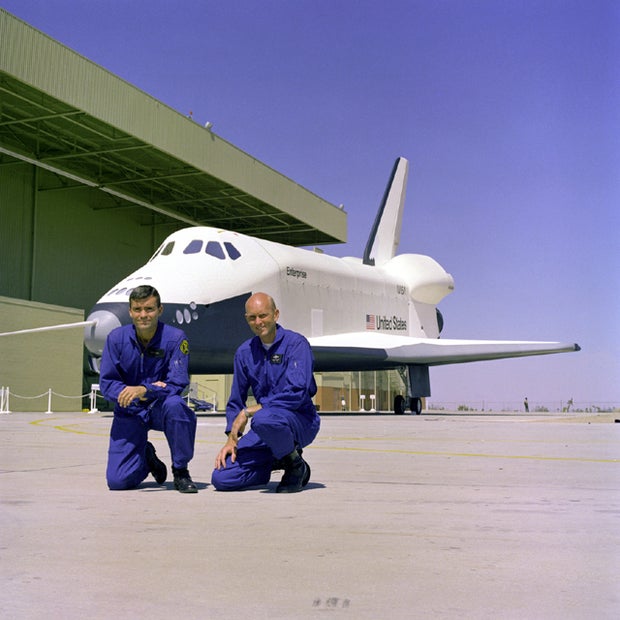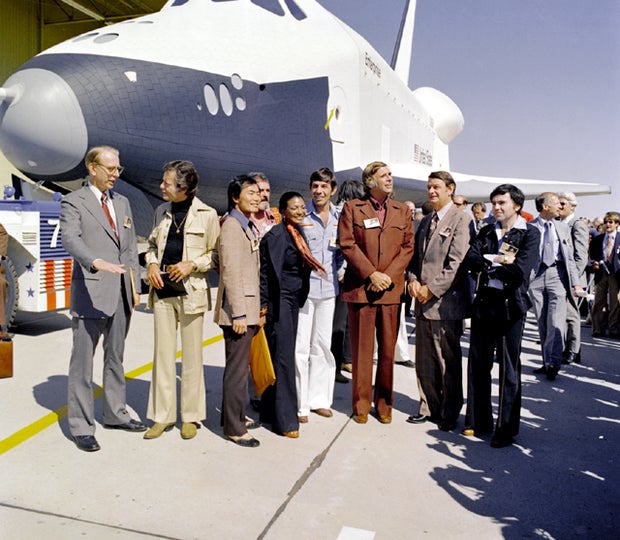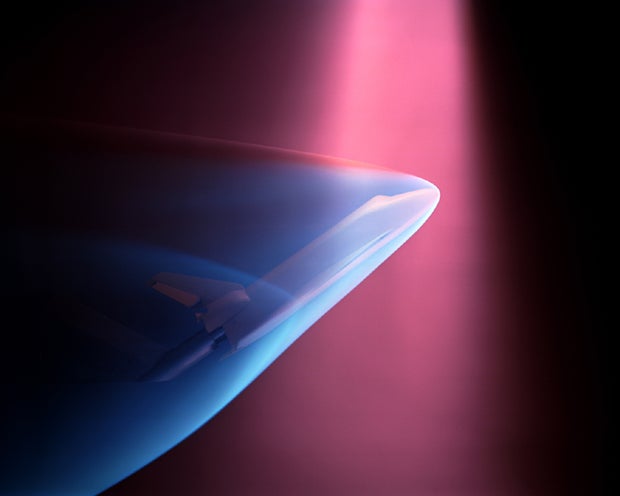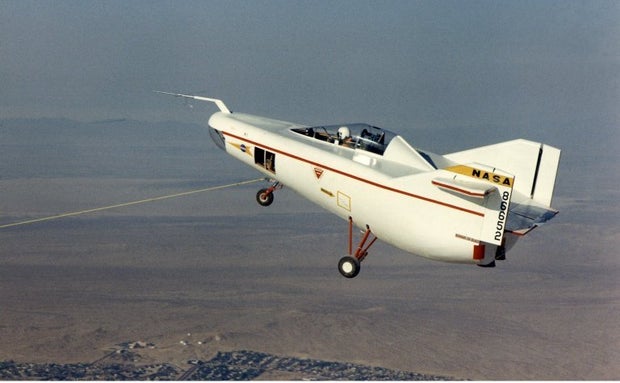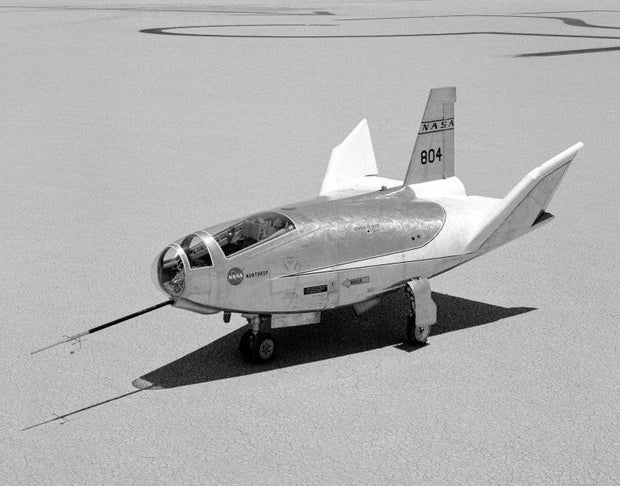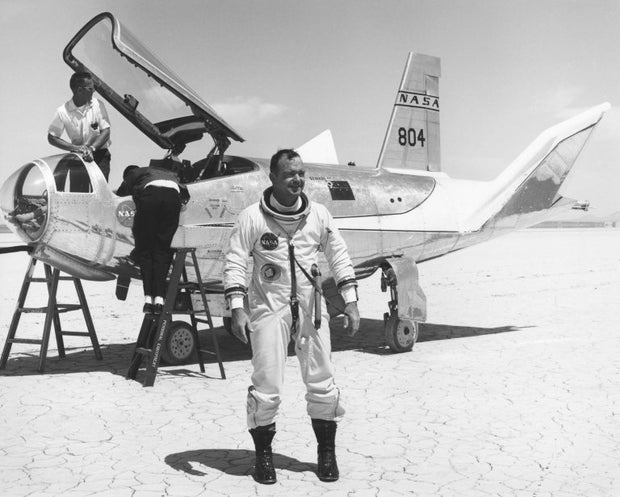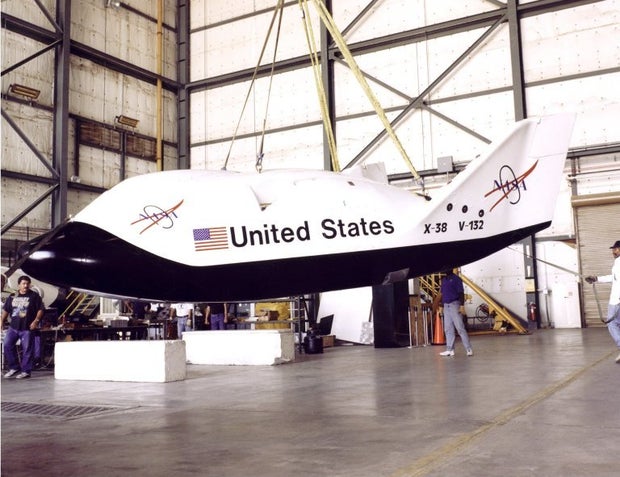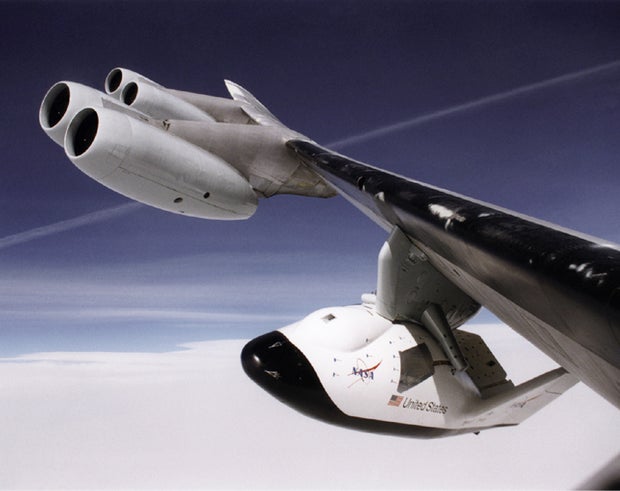Precursors to the Space Shuttle
NASA often refers to its space shuttles as orbiters, but the very first of the shuttles never actually made it into orbit. Then again, it wasn't supposed to. In 1977, four years before the shuttle Columbia would become the first of the airplane-like spacecraft to leave the atmosphere (the anniversary is Monday), NASA conducted a series of ground and flight tests with a version called the Enterprise.
The shuttle Enterprise, officially designated OV-101, was commanded by former Apollo 13 astronaut Fred Haise (left), teamed with C. Gordon Fullerton, who served as pilot. (Two other NASA astronaut crew members, Joe Engle and Dick Truly, also got a chance at the helm.)
'Star Trek' cast
If the Enterprise name puts you in mind of a certain outer-space TV show, that's by design. Originally, the orbiter was to be called the Constitution--its final assembly occurred in 1976, the bicentennial year for the United States. But fans of the show "Star Trek" (at the time, there had been only the one, and no movies yet) mounted a write-in campaign to get the shuttle to carry the name of the show's famed starship. Thus, NASA's creation became the Enterprise.
This photo from the shuttle's rollout in September 1976, at Rockwell's Palmdale, Calif., assembly facility, is both a snapshot of the newly christened Enterprise and a time capsule of 1970s apparel. The group here includes both NASA officials and cast members from the original "Star Trek" series, pictured from left to right: James D. Fletcher, NASA administrator; DeForest Kelley (the TV show's Dr. McCoy); George Takei (Mr. Sulu); Nichelle Nichols (Lt. Uhura); Leonard Nimoy (Mr. Spock); Gene Rodenberry (the creator of "Star Trek"); an unidentified man; and Walter Koenig (Ensign Pavel Checkov). The bearded fellow behind Takei and Nichols would seem to be James Doohan (Scotty from the show), but the NASA site provides no identifying information.
Shuttle separates from 747
Enterprise flies free
Free flight
The Enterprise flies over the Southern California desert. For the final two free flights, the tail cone--which had been used to minimize turbulence--was removed, since that would be the actual configuration on return from space. The final flight came to a close with a landing on the concrete runway at Edwards AFB, again simulating a return from an actual orbital mission; the landings for the previous four flights were on the Edwards dry lake bed.
NASA says that the fifth and final approach and landing test revealed a problem with the shuttle's flight control system that could have led to a dangerous situation called pilot-induced oscillation--a flaw corrected by further research.
Marshall test stand
In March 1978, now at NASA's Marshall Space Flight Center in Alabama, the orbiter was joined for the first time with the other main elements of the shuttle lift-off system: the big external fuel tank and a pair of solid rocket boosters. The whole system was set into Marshall's dynamic test stand--with the shuttle's nose pointed skyward, as it would be for an actual launch--for ground vibration tests. (Here, the Enterprise is being hoisted into the test stand.)
Testing at Marshall continued until March 1979, after which the whole Enterprise lift-off rig was set up at the Kennedy Space Center in Florida for a checkout of the launch complex that would be used for the actual orbital flights, the first of which would come in April 1981 when the shuttle Columbia spent two days in space.
Wind tunnel
Lifting-body designs
Well before the shuttle Enterprise came along (assembly began in 1974), NASA researchers were already cooking up ideas for "lifting body" spacecraft that didn't look or work exactly like a tubular rocket. Throughout the 1960s and into the early 1970s, NASA worked through a series of lifting-body prototypes that it says were quite influential on the eventual shuttle program.
This artist's rendering from 1962 shows three such designs, from left to right: the M2-F1, the M1-L, and a lenticular shape. The wingless structure--the body of the vehicle itself provides the lift in the atmosphere--would allow for a horizontal re-entry, like the descent of an airplane, which in turn would mean less damage from the extreme heat of re-entry, according to the space agency. It was the M2-F1 design that would soon enough be flying.
M2-F1 behind C-47
The M2-F1 flies at the end of a tow rope behind a C-47 aircraft, probably sometime in 1964. During this series of tests, the C-47 would tow the prototype spacecraft to an altitude of 12,000 feet, and then release it to glide back to the Rogers Dry Lake bed at Edwards Air Force Base, California, in a descent that NASA says typically would take about two minutes, with speeds topping out at about 120 miles per hour.
Earlier flight tests had involved being towed from the ground by what NASA calls "a hopped-up Pontiac convertible." The space agency elaborates: "Walter 'Whitey' Whiteside, who was a retired Air Force maintenance officer working in the [Flight Research Center]'s Flight Operations Division, was a dirt-bike rider and hot-rodder. Together with Boyden 'Bud' Bearce in the Procurement and Supply Branch of the FRC, Whitey acquired a Pontiac Catalina convertible with the largest engine available. He took the car to Bill Straup's renowned hot-rod shop near Long Beach for modification. With a special gearbox and racing slicks, the Pontiac could tow the 1,000-pound M2-F1 110 miles per hour in 30 seconds."
Altogether, there were about 400 ground tows and 77 aircraft tows for the M2-F1.
M2-F1 with test pilot
M2-F2 with B-52
James Doohan meets pilot Bruce Peterson
We return to the "Star Trek" theme for a moment with this 1967 photo of actor James Doohan meeting NASA's Bruce Peterson, a test pilot and engineer, in front of the M2-F2. In May 1967, Peterson was injured in a crash during his fourth glide flight of the M2-F2 and its 16th overall, which was planned to be the last before the start of powered flights. NASA describes the incident at length:
"[A]s pilot Bruce Peterson neared the lake bed, the M2-F2 suffered a pilot-induced oscillation (PIO). The vehicle rolled from side to side in flight as he tried to bring it under control. Peterson recovered, but then observed a rescue helicopter that seemed to pose a collision threat. Distracted, Peterson drifted in a cross-wind to an unmarked area of the lake bed where it was very difficult to judge the height over the lake bed because of a lack of the guidance the markers provided on the lake bed runway.
"Peterson fired the landing rockets to provide additional lift, but he hit the lake bed before the landing gear was fully down and locked. The M2-F2 rolled over six times, coming to rest upside down. Pulled from the vehicle by Jay King and Joseph Huxman, Peterson was rushed to the base hospital, transferred to March Air Force Base and then the UCLA Hospital. He recovered but lost vision in his right eye due to a staph infection."
HL-10
A sister ship to the M2-F2 was the HL-10, parked here on Rogers Dry Lake bed. NASA says the HL-10 ("HL" for "horizontal landing") was the best of the original heavyweight lifting bodies. It flew 37 times during the research program. Like the M2-F2, it was built by Northrop.
"This 1968 photo shows the vehicle after the fins were modified to remove instabilities encountered on the first flight," says NASA. Driven by wind tunnel testing, according to the space agency, those modifications "involved a change to the shape of the leading edge of the fins to eliminate flow separation...NASA Flight Research Center (FRC) engineer Bob Kempel then plotted thousands of data points by hand to come up with the modification, which involved a fiberglass glove backed with a metal structure on each fin's leading edge."
Bill Dana and HL-10
X-24B
X-33
X-38 in hangar
Another recent prototype was the X-38 Crew Return Vehicle design, which NASA says was intended to help develop a spacecraft that could serve as a "lifeboat" for the International Space Station, among other uses. In this 1998 photo, an X-38 sits in a hangar at NASA's Dryden Flight Research Center. The project used off-the-shelf technology in order to keep costs down. For instance, NASA says, the flight computer in the X-38 was commercial equipment that was in use in aircraft at the time, and the flight software operating system also was a commercial system.
Clearly reflecting its lifting-body lineage, the X-38 prototype vehicle (several were made) was 28 feet long and 14 feet wide, and weighed approximately 16,000 pounds. The X-38 was built by Scaled Composites, which more recently has been involved in the SpaceShipOne and SpaceShipTwo projects that are at the forefront of the nascent commercial spaceflight industry.
X-38 on B-52 pylon
Flight testing of the X-38 prototypes in the late 1990s and through at least 2001 included captive carries attached to the wing of Dryden's B-52 008 (shown here), along with parachute and parafoil drop tests and free flights. The X-38 program, however, was canceled shortly after the turn of the century.
Since then, NASA has turned its attention to other projects. One, the Orion crew vehicle, apparently met its demise earlier this year when the federal government cut off funding for the Constellation project. Another, the X-37, is now being used for research by the U.S. Air Force, which plans to send the autonomous X-37B test vehicle into space later this month.
